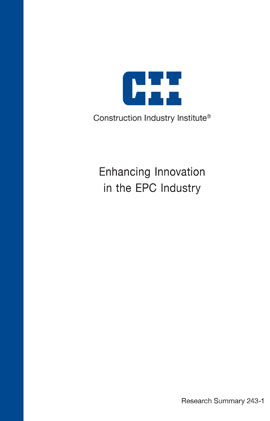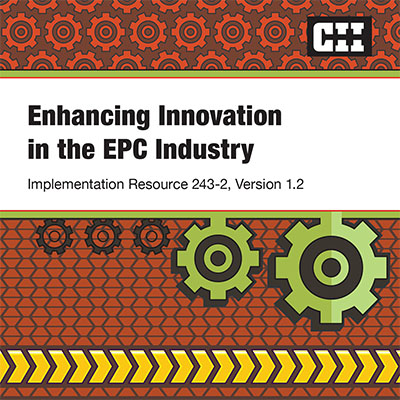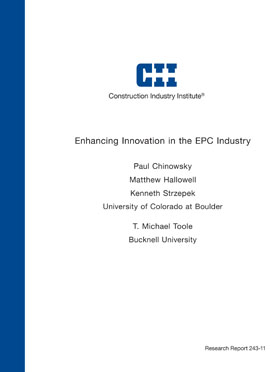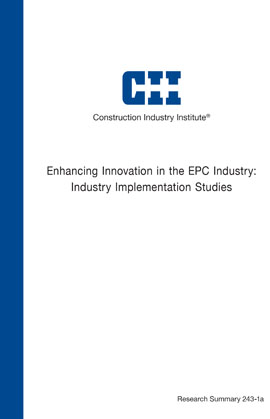
Enhancing Innovation in the EPC Industry
To stay competitive, engineering, procurement, and construction (EPC) organizations must approach innovation with a focus on internal investment and cross-industry adoption. To motivate the EPC industry to move robustly in this direction, the industry must challenge the tradition-bound elements of the industry culture and manage its adoption of innovation. Fundamental to this shift is the need for an economic perspective that grasps the financial benefit of pursuing innovation over the financial risk of maintaining status quo. Taking such a total innovation perspective is crucial to expanding innovation within the EPC industry and within the key areas addressed in this research effort.
Through a literature search, structured interviews, and a survey of nearly 200 EPC professionals, this research—co-sponsored by the Charles Pankow Foundation (CPF)—provides empirical evidence that a significant gap exists between an effective approach to innovation and the industry’s current approach—even that of the most progressive EPC-based firms. This gap includes the following elements of innovation management: mindset, resources, processes and structure, and changed project environments. Below are the research team’s findings on these elements:
- Mindset: While EPC firms have a culture that generally affirms the importance of innovation, managers apparently enable innovation only on a project-by-project basis. They seem not to adopt a long-term, multiple-project, risk-tolerant perspective that enables innovation on an organization-wide basis.
- Resources: The majority of respondents indicated that their companies lack the resources necessary to identify, nurture, track, and apply innovations. These resources would include expense budgets as well as managing staff to ensure that sufficient time could be devoted to nurturing innovation.
- Processes and Structure: The innovation literature makes it clear that innovation will rarely happen when managers’ leadership on innovation is passive. Rather, innovation requires active leader commitment and formalized processes within the organization. This organizational structure should allow employees to methodically identify and evaluate potential innovations. Once identified and assessed, the organization’s structured processes should promote to effective implementation of the innovations on appropriate projects.
- Changed Project Environments: Successful innovation requires real and sustained commitment from all project entities. Project delivery and contract methods that inhibit collaboration between entities during design and construction, and that prevent risk-taking, are not conducive to the creative integration needed for innovation.
In response to these findings, the research team developed two processes to help advance innovation within EPC organizations: (1) an innovation maturity model and (2) an economic model that demonstrates the value of innovation investment. The Innovation Maturity Model is an evaluation tool that measures the current state of an organization’s innovation and provides recommendations for advancing innovation. The economic model developed by the team supports these recommendations by illustrating and communicating the long-term benefits of innovation investment. The challenge for EPC organizations is determining how and where to start on the path to innovation; this progress entails identifying the areas of the organization that need investment to encourage innovation.
We have a problem with innovation in the EPC industry. The data analysis and research compiled show survey results in five areas: (RS243-1, p. 11)
- Innovation Perception
- Innovation Actions
- Innovation Processes
- Innovation Funding
- Innovation Drivers
Perception of how innovative the EPC industry is currently.
{^widget|(widget_displayname)WatermarkImage|(name)WatermarkImage|(image)%7e%2fCII%2fmedia%2fPublications%2f243_1figure2.JPG%3fext%3d.jpg|(width)|(height)^}
Perception of how innovative the respondent’s organization is in comparison to the EPC industry.
{^widget|(widget_displayname)WatermarkImage|(name)WatermarkImage|(image)%7e%2fCII%2fmedia%2fPublications%2f243_1figure3.JPG%3fext%3d.jpg|(width)|(height)^}
Where innovation is most needed in the organization.
The research provides five key enablers for innovation. (RS243-1, p. 21)
- Innovation is a foundation of the organization culture.
- Budget allocations must be made to support innovation.
- Resource allocations must be made to support innovation.
- Processes must support innovation.
- A new risk perspective should be adopted.
The research provides a model to assist organizaitons in determing their status as innovators. The following eight attributes are found to lead to successful identification, adoption, and diffusion of innovation in the EPC industry. (RS243-1, p. 23)
- Culture
- Resources
- Risk perspective
- Customer focus
- Learning
- Collaboration
- Leadership
- Processes
See Implementation Tools for further details.
See Implementation Tools for further details.
Supports the recommendations of the IMM by illustrating and communicating the long-term benefits of innovation investment. (RS243-1, p. 27)



